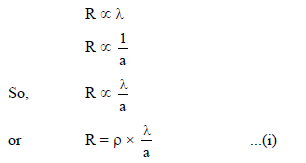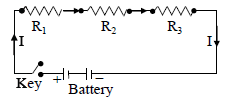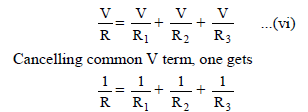Please refer to the Electricity Revision Notes given below. These revision notes have been designed as per the latest NCERT, CBSE and KVS books issued for the current academic year. Students will be able to understand the entire chapter in your class 10th Science book. We have provided chapter wise Notes for Class 10 Science as per the latest examination pattern.
Revision Notes Chapter 1 Electricity
Students of Class 10 Science will be able to revise the entire chapter and also learn all important concepts based on the topic wise notes given below. Our best teachers for Grade 10 have prepared these to help you get better marks in upcoming examinations. These revision notes cover all important topics given in this chapter.
ELECTRIC CURRENT (CHARGE IN MOTION)
Definition : The quantity of electric charge flowing through cross section of a given conductor in one second is called current.
Thus, if Q is the charge which flows through a conductor in time t, then the current (I) is given by
Current (I) =Charge (Q)/Time (t)
The electric current (or current) is a scalar quantity.
Unit of current
The SI unit of charge (Q) is coulomb (C), and
that of time (t) is second (s). So,
SI unit of current
=I coulomb/1second
= 1 C s–1 = 1 ampere
The unit coulomb per second (Cs–1) is called ampere (A)
Direction of Electric Current :
The direction of flow of the positive charge taken as conventional direction of the electric current. When we consider the flow of electric current in an ordinary conductor, such as a copper wire, the direction of current is taken as opposite to the direction of the flow of electrons.
FLOW OF CURRENT IN A METAL
Metals show a very different kind of bonding called metallic bonding. According to this bonding, the outermost electrons are not bound to any particular atom, and move freely inside the metal randomly as shown in fig. So, these electrons are free electrons. These free electrons move freely in all the directions. Different electrons move in different directions and with different speeds. So there is no net movement of the electrons in any particular direction. As a result, there is no net flow of current in any particular direction.

ELECTRIC SYMBOLS
Many different kinds of equipments or components are used in setting up electrical circuits. To draw the diagrams of electrical circuits on paper these equipments/components are shown by their symbols. Here are some symbols used in the electric circuit diagrams.

OHM’S LAW
Definition : According to the Ohm’s law at constant temperature, the current flowing through a conductor is directly proportional to the potential difference across the conductor.
Thus, if I is the current flowing through a conductor and V is the potential difference (or voltage) across the conductor, then according to Ohm’s law.
I ∝ V (when T is constant)
or, I =V/R …(i)
where R is a constant called the resistance of the conductor.
Equation (i) may be written as,
V = I × R
Unit of resistance :
The SI unit of resistance (R) is ohm. Ohm is denoted by the Greek letter omega (Ω).
From Ohm’s law, R = I/V
Now, if, V = 1 volt and I = 1 ampere
Then, R = 1volt/1ampere
Thus, 1 ohm is defined as the resistance of a conductor which allows a current of 1 ampere to flow through it when a potential difference of 1 volt is maintained across it.
Results of Ohm’s law
Current flowing through a conductor is directly proportional to the potential difference across the conductor.

When the potential difference in a circuit is kept constant, the current in inversely proportional to the resistance of the conductor.
I ∝ 1/R
The ratio of potential difference to the current is constant. The value of the constant is equal to the resistance of the conductor (or resistor).
V/I = R
RESISTANCE OF CONDUCTOR
The movement of electron gives rise to the flow of current through metals. The moving electrons collide with each other as well as with the positive ions present in the metallic conductor. These collisions tend to slow down the speed of the electrons and hence oppose the flow of electric current. The property of a conductor by virtue of which it opposes the flow of electric current through it is called its resistance.
Resistance is denoted by the letter R.
The SI unit of resistance is ohm. The ohm is denoted by the Greek letter (Ω) called omega.
Resistance is a scalar quantity.
Factors on which resistance of conductor depends
Effect of the length on the resistance of a conductor
The resistance of a conductor is directly proportional to the length. That is Resistance of a conductor. ∝ Length of the cond.
Effect of the area of cross-section on the resistance of a conductor
The resistance of a conductor is inversely proportional to its area of cross-section.
That is,
Resistance of a conductor ;
R ∝1/Area of cross sec tion (a) of the conductor
* If the area of cross-section of the conductor is doubled, its resistance gets halved.
Effect of temperature on the resistance of a conductor
The resistance of all pure metals increases with a rise in temperature. The resistance of alloys increases very slightly with a rise in temperature. For metal when temperature increases resistance increases and for semiconductors when temperature increases resistance decreases.
Effect of the nature of material on the resistance of a conductor
Some materials have low resistance, whereas some others have much higher resistance. In general, an alloy has higher resistance than pure metals which from the alloy.
* Copper, silver, aluminium etc., have very low resistance.
* Nichrome, constantan etc., have higher resistance. Nichrome is used for making heating elements of heaters, toasters, electric iron etc.
RESISTIVITY

where ρ (rho) is called resistivity of the material of conductor.
If, l = 1 m and a = 1 m2
Then R = ρ …(ii)
Thus, if we take 1 metre long piece of a substance having a cross-sectional area of 1 meter2, then the resistance of that piece of the substance is called its resistivity.
Resistivity of a substance can also be defined as follows :
The resistance offered by a cube of a substance having side of 1 metre, when current flows perpendicular to the opposite faces, is called its resistivity.
Units of resistivity
From equation (i), we can write

So, SI unit of resistivity (ρ) =(ohm×m2)/m = ohm.m
Thus, the SI unit of resistivity is ohm. m (or Ω. m)
Classification of Material on Basis of Resistivity
Substances showing very low resistivities :
The substances which show very low resistivities allow the flow of electric current through them. these type of substances are called conductors.
For example, copper, gold, silver, aluminium and electrolytic solutions are conductors.
Substances having moderate resistivity:
The substances which have moderate resistivity offer appreciable resistance to the flow of electric current through them.
Therefore, such substances are called resistors. For example, alloys such as nichrome, manganin, constantan and carbon are typical resistors.
Substances having very high resistivity:
The substances which have very high resistivities do not allow electricity to flow through them. The substances which do not allow electricity to pass through them are called insulators. For example, rubber, plastics, dry wood, etc. are insulators.
COMBINATION OF RESISTANCES
Series Combination
When two or more resistances are joined end-toend so that the same current flows through each of them, they are said to be connected in series.

When a series combination of resistances is connected to a battery, the same current (I) flows through each of them.
Law of combination of resistances in series: The law of combination of resistances in series states that when a number of resistances are connected in series, their equivalent resistance is equal to the sum of the individual resistances. Thus, if R1, R2, R3 …, etc. are combined in series, then the equivalent resistance (R) is given by,
R = R1 + R2 + R3 + … ….(i)
Derivation of mathematical expression of resistances in series combination : Let, R1,R2 and R3 be the resistances connected in series, I be the current flowing through the circuit, i.e., passing through each resistance, and V1, V2 and V3 be the potential difference
across R1, R2 and R3, respectively. Then, from Ohm’s law,
V1 = IR1, V2 = IR2 and V3 = IR3 …(ii)
If, V is the potential difference across the combination of resistances then,
V = V1 + V2 + V3 …(iii)
If, R is the equivalent resistance of the circuit,
then V = IR …(iv)
Using Eqs. (i) to (iv) we can write,
IR = V = V1 + V2 + V3
= IR1 + IR2 + IR3
or, IR = I (R1 + R2 + R3)
or, R = R1 + R2 + R3
Therefore, when resistances are combined in series, the equivalent resistance is higher than each individual resistance.
Some results about series combination :
(i) When two or more resistors are connected in series, the total resistance of the combination is equal to the sum of all the individual resistances.
(ii) When two or more resistors are connected in series, the same current flows through each resistor.
(iii)When a number of resistors are connected in series, the voltage across the combination
(i.e. voltage of the battery in the circuit), is equal to the sum of the voltage drop (or potential difference) across each individual resistor.
Parallel Combination
When two or more resistances are connected between two common points so that the same potential difference is applied across each of them, they are said to be connected is parallel.

When such a combination of resistance is connected to a battery, all the resistances have the same potential difference across their ends.
Derivation of mathematical expression of parallel combination :
Let, V be the potential difference across the
two common points A and B. Then, from Ohm’s law
Current passing through R1,I1 = V/R1 …(i)
Current passing through R2,I2 = V/R2 …(ii)
Current passing through R3,I3 = V/R3 …(iii)
If R is the equivalent resistance, then from Ohm’s law, the total current flowing through the circuit is given by,
I = V/R …(iv)
and I = I1 + I2 + I3 …(v)
Substituting the values of I,I1,I2 and I3 in Eq. (v),

The equivalent resistance of a parallel combination of resistance is less than each of all the individual resistances.
Important results about parallel combination :
(i) Total current through the circuit is equal to the sum of the currents flowing through it.
(ii) In a parallel combination of resistors the voltage (or potential difference) across each resistor is the same and is equal to the applied voltage i.e. v1 = v2 = v3 = v :
(iii) Current flowing through each resistor is inversely proportional to its resistances, thus higher the resistance of a resistors, lower will be the current flowing through it.



